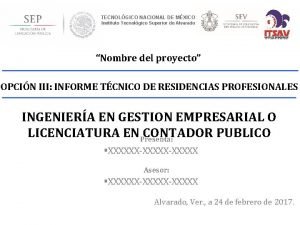XXXIV SALN TECNOLGICO DE LA CONSTRUCCIN EXCO 2020

- Slides: 1

XXXIV SALÓN TECNOLÓGICO DE LA CONSTRUCCIÓN EXCO 2020 INTERNATIONAL ITINERANT EXHIBITION “RESEARCH IN BUILDING ENGINEERING – EXCO’ 20” - Valencia SPAIN DISEÑO Y CONSTRUCCIÓN DE PAVIMENTOS DE HORMIGÓN POROSO EN AMBIENTE FRÍO DESIGN AND CONSTRUCTION OF PERVIOUS CONCRETE PAVEMENTS IN COLD ENVIRONMENT L. V. García-Ballester 1, 2, 3, José R. Albiol-Ibáñez 1, 2, 3, C. Subero-González 2, 3 Dpto. Construcciones Arquitectónicas 1; Universitat Politècnica de València 2; ETS. Ingeniería de Edificación 3 INTRODUCCIÓN El hormigón poroso es un tipo especial de hormigón caracterizado por una red de poros interconectados y una relación contenido de hueco/porosidad (h/pr) alta (15 a 35% por volumen). Aunque contiene los componentes del hormigón convencional: áridos, cemento, agua y, en su caso, aditivos, la utilización de una granulometría discontinua y con nula o escasa cantidad de árido fino, permite obtener estructura porosa que es muy permeable. Debido a esto presenta ventajas importantes para su utilización en pavimentos al aire libre, ya que permite una disminución de la escorrentía de aguas pluviales, limpieza del agua de lluvia a través de filtración y degradación microbiana, y menor potencial de deslizamiento sobre el pavimento INTRODUCTION Pervious concrete is a special type of concrete characterized by a network of interconnected pores and a high void / porosity content ratio (h / pr) (15 to 35% by volume). Although it contains the components of conventional concrete: aggregates, cement, water and, where appropriate, additives, the use of a discontinuous granulometry and with little or no amount of fine aggregate, allows to obtain porous structure that is very permeable. Due to this it presents important advantages for its use in outdoor pavements, since it allows a decrease in the runoff of rainwater, cleaning of rainwater through filtration and microbial degradation, and lower potential of sliding on the pavement OBJETIVOS El trabajo plantea como objetivo el estudio y desarrollo de un hormigón poroso, utilizado como pavimento para tráfico ligero, en ambiente frío y en ambiente frío salino. Para la evaluación y análisis de estas propiedades se utilizaron las resistencias a compresión y flexión, el coeficiente de permeabilidad y el criterio de pérdida masa. Objetives The work aims to study and develop a porous concrete, used as a pavement for light traffic, in a cold environment and in a cold saline environment. For the evaluation and analysis of these properties, the compression and bending strengths, the permeability coefficient and the mass loss criterion were used. PLAN EXPERIMENTAL / EXPERIMENTAL PLAN Materiales Se confeccionaron cuatro mezclas con diferente matriz y estructura porosa para determinar su permeabilidad y resistencia frente al hielodeshielo. La tabla 1 muestra la dosificación de las mezclas. Materials Four mixtures with different matrix and porous structure were made to determine their permeability and freeze-thaw resistance. Table 1 shows the dosage of the mixtures. Tabla 1. Dosificaciones hormigones / Table 1. Mix design concrete H 1 343 93, 30 0 1. 569, 80 1, 715 0, 27 H 2 343 108, 80 0 1. 569, 80 1, 71 0, 33 H 3 305 100, 65 126, 70 1. 457, 20 1, 52 0, 33 H 4 300 80, 73 87, 97 1. 309, 15 1, 50 0, 27 Ensayo de resistencia al hielo-deshielo. Probetas en cámara climática y se sometieron a 7, 14 y 28 ciclos de hielo-deshielo, de acuerdo con la curva de temperatura-tiempo mostrada en la Imagen 2. Se realizó en dos tipos de medios: • neutro (sin agentes agresivos), con agua desionizada y • solución de Na. Cl al 3% HORMIGÓN CONCRETE H 1, H 2, H 3 H 4 Ensayo de permeabilidad / Permeability Test Tiempo / Time (s) Tabla 3. Coeficiente de permeabilidad k Table 3. Permebility coefficient k Tipo de hormigón / Concrete type Imagen 7. Tiempo de permeabilidad Image 7. Permeability Time H 1 H 2 H 3' H 4 1. 452 2, 5 A (cm 2) / AMASADAS/BATCH PROBETASAMASADA/ SPECIMENS BY BATCH 6 de 30 litros / liters 2 de 30 x 10 cm 2 de 40 x 10 cm 2 de 10 x 10 cm 2 de 50 litros / liters 2 de 30 x 10 cm 2 de 40 x 10 cm 2 de 10 x 10 cm 6 de 15 x 15 cm Permeabilidad / Permeability Flexión / Bendig Compresión / Compression Heladicidad / Freeze-Thaw T (s) 9, 580 8, 687 8, 042 8, 503 19, 720 7, 903 K (cm/s) 7, 539 8, 314 8, 494 3, 662 9, 138 Imagen 3. Ensayo de consistencia Image 3. Slump Test CONGELACIÓN/ FREEZE Imagen 5. Curva de temperatura para un ciclo H-D. Image 5. Temperature curve for F/T cycle Tabla 5. Pérdida de masa superficial. Table 5. Loss of surface mass/Scaling Probeta Area/ / Surface Specim A en (mm 2) 1 22. 500 4 22. 500 5 22. 500 6 22. 500 7 ciclos/cycles 14 ciclos/cycles 28 ciclos/cycles Pérdida de Sn Sn Sn masa/Scaling (kg/m 2) (g) (g) 2, 1 0, 093 1, 7 0, 075 135, 4 5, 970 1. 566, 6 69, 620 1, 2 0, 053 1, 3 0, 057 80, 9 3, 590 425, 7 18, 92 1. 815, 5 80, 680 Conclusiones El asiento nulo y la presencia o no de arena no condicionan la cohesión de la masa ya que en todos los casos la forma de asiento ha sido correcta. Paro el rango de relaciones a/c de los hormigones porosos es preferible utilizar un valor de ésta tan alto como sea posible para las condiciones de aplicación y uso. Cuanto mayor sea el grado de compactación, mayor será resistencia del hormigón poroso y menor su permeabilidad. A una mayor densidad de un hormigón poroso, disminuye la permeabilidad y aumenta su resistencia. La cantidad de aditivo superplastificante influye en la formación de la estructura porosa. Con las dosificaciones utilizadas, el hormigón estudiado es apto para su aplicación como pavimento ligero en clima frío con ambiente no salino El hormigón poroso en climas fríos con ambiente salino experimenta una gran pérdida de masa superficial. Tras someter a las probetas a 28 ciclos de hielo-deshielo, no se ven modificadas sus propiedades mecánicas en medio de congelación neutro. 7 ciclos / cycles 14 ciclos / cycles 28 ciclos / cycles Specimen 1 Specimen 4 Specimen 5 Specimen 6 Imagen 8. Pérdida de masa superficial a 7, 14 y 28 ciclos Image 8. Loss of surface mass/Scaling at 7, 14 and 28 cycles Edad / Age 7 días / days 28 días / days 60 días / days Ensayo Compresión/Compression Flexión/Bending Hormigón Peso Resistencia Peso Resistencia Peso Concrete Weigth Stregth Weigth Stregth (kg) (MPa) (kg) (MPa) H 1 1, 865 8, 3 7, 9 1, 3 1, 912 6, 4 7, 6 1, 7 1, 972 10, 8 2, 1 H 2 1, 687 10, 8 7, 2 1, 7 1, 874 13, 4 7, 5 2, 2 1, 831 13, 1 2, 1 H 3 1, 779 9, 6 7, 4 1, 9 1, 740 8, 3 7, 9 2, 3 1, 804 11, 7 2, 0 H 3' 1, 943 18, 4 8, 3 2, 037 23, 3 8, 1 2, 5 2, 193 25, 1 3, 4 H 4 1, 987 17, 0 8, 0 3, 6 - (a) (b) Imagen 6. (a) Corte probeta. (b) Probeta cortada Image 6. (a) Cutting Specimen cut. (b) Specimen cut Ensayo de resistencia al hielo-deshielo / Freeze-Taw Reistance Test Tabla 4. Resultados de los ensayos de compresión y flexión / Table 4. Results of the compression and bending tests Imagen 4. Ensayo de permeabilidad Image 4. Permeability Test DESCONGELACIÓN/ TAWING Ensayo de resistencia a compresión y a flexión / Compression and bending tests Terreno natural / Soil Sub-base. Zahorra artificial+natural / Sub-base Artificial + natural sack Grava / Gravel D=25 mm Hormigón Poroso / Pervious Concrete Geotetxtil / Geotextil Imagen 2. Sección pavimento ligero / Image 2. Lightweigth pavement section ENSAYO / TEST Permeability Test Coefficient of permeability according to the formula is determined: k = Q / A i t where: Q amount of water drained at time t (cm 3) i hydraulic gradient (H / L), where H = 25 cm and L = 10 cm A Area of the sample section tested (cm 2) t test time (sec) Freeze-thaw resistance test. Specimens in climatic chamber and subjected to 7, 14 and 28 freeze-thaw cycles, according to the temperature-time curve shown in Image 2. It was carried out in two types of media: • neutral (without aggressive agents), with deionized water and • 3% Na. Cl solution RESULTADOS / RESULTS Ensayo de consistencia / Slump Test Asiento cero, deformación prácticamente nula y sin pérdida de cohesión i Tabla 2. Programa experimental / Table 2. Experimental Plan Ensayo de permeabilidad Coeficiente de permeabilidad de acuerdo con la formula: k=Q/Ait donde: Q cantidad de agua escurrida en un tiempo t (cm 3) i gradiente hidráulico (H/L), siendo H= 25 cm y L= 10 cm A área de la sección de muestra ensayada (cm 2) t tiempo de ensayo (seg) HORMIGÓN/ Q CONCRETE (cm 3) Pérdida de peso / Scaling (g) COMPONENTES / COMPONENTS CEM II B 42, 5 R kg Agua / Water l Arena silicea / Silica Sand 0/4 kg Grava / Crushed Agg 4/12, 5 kg Aditivo / Admixture (2%) l Relación a/c / Ratio w/c Imagen 1. Hormigón Poroso Image 1. Pervious Concrete Conclusions 1 4 6 Imagen 9. Probetas tras 28 ciclos: 4 y 6 destrozadas. 1 intacta. Image 9. Specimens after 28 cycles: 4 a 6 destroyed. 1 intact Imagen 10. Fisuración de áridos Image 10. Cracking of aggregates The slump zero and the presence or absence of sand do not condition the cohesion of the mass since in all cases the slump form has been correct. For the range of a / c ratios of porous concretes, it is preferable to use a value as high as possible for the conditions of application and use. The greater the degree of compaction, the greater the resistance of the porous concrete and the lower its permeability. At a higher density of a porous concrete, the permeability decreases and its strength increases. The amount of superplasticizer additive influences the formation of the porous structure. With the mix design used, the concrete studied is suitable for application as a lightweight pavement in cold weather with non-saline environment Pervious concrete in cold climates with saline environment experiences a great loss of surface mass. After subjecting the samples to 28 freeze-thaw cycles, their mechanical properties are not modified in a neutral freezing medium

